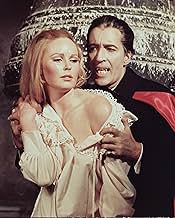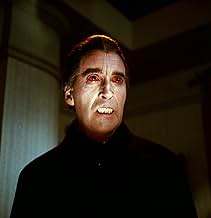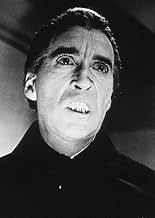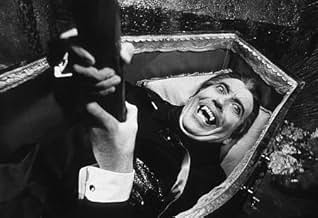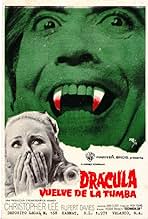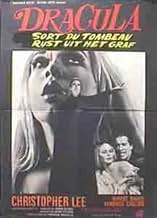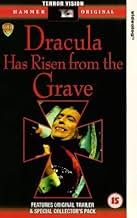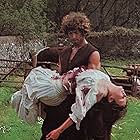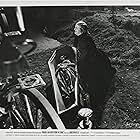IMDb RATING
6.5/10
8.6K
YOUR RATING
After a Monsignor accidentally brings Count Dracula back from the dead while exorcising his castle, the vampire preys on the holy man's beautiful niece and her friends.After a Monsignor accidentally brings Count Dracula back from the dead while exorcising his castle, the vampire preys on the holy man's beautiful niece and her friends.After a Monsignor accidentally brings Count Dracula back from the dead while exorcising his castle, the vampire preys on the holy man's beautiful niece and her friends.
- Director
- Writers
- Stars
- Awards
- 1 nomination total
Christopher Cunningham
- Farmer
- (as Chris Cunningham)
Carrie Baker
- First victim
- (uncredited)
Donald Campbell
- Tavern Customer
- (uncredited)
Frank Forsyth
- Villager
- (uncredited)
Lindsay Hooper
- Tavern Customer
- (uncredited)
Philip Stewart
- Tavern Customer
- (uncredited)
John Timberlake
- Tavern Customer
- (uncredited)
- Director
- Writers
- All cast & crew
- Production, box office & more at IMDbPro
Featured reviews
When his castle is exorcised, Dracula (Christopher Lee) plots his revenge against the Monsignor (Rupert Davies) who performed the rites by attempting to make the holy man's young niece his bride.
This film is scandalous. Sure it passed the censors, and that is great, and Lee gives another great Dracula performance (with Davies as a more than adequate nemesis). But what we have here is an atheist in the home of a clergyman! Can you be an atheist and still believe in vampires?
Apparently, this was the most commercially successful of the Hammer Dracula films. I am not surprised, as it is quite entertaining. And with all due respect to Terence Fisher, I think I tend to prefer Freddie Francis' direction a little more. Francis knows his camera, and I think that adds something to his directing prowess.
This film is scandalous. Sure it passed the censors, and that is great, and Lee gives another great Dracula performance (with Davies as a more than adequate nemesis). But what we have here is an atheist in the home of a clergyman! Can you be an atheist and still believe in vampires?
Apparently, this was the most commercially successful of the Hammer Dracula films. I am not surprised, as it is quite entertaining. And with all due respect to Terence Fisher, I think I tend to prefer Freddie Francis' direction a little more. Francis knows his camera, and I think that adds something to his directing prowess.
Early on, "Dracula Has Risen from the Grave" made me feel uneasy... From the scenes of a Monsignor (Rupert Davies) traveling with a priest to perform an exorcism on Castle Dracula in order to bring the superstitious (ha!) congregation back to church on Sunday, to the romantic subplot between a scholarly baker and the Monsignor's daughter, and a distinct lack of Drac, I began to wonder if I was being shortchanged by a title that looked to just capitalize on the success of the Hammer Dracula films. However, the more I kept with it, the more I enjoyed "Grave"--the above-mentioned plot threads, which at first seem corny, are interwoven with delicate skill by director Freddie Francis; the characters and their conflicts are surprisingly endearing (including an angle that brings atheism into the mix); and Christopher Lee is in fine form as the brooding, red-eyed Count (though the production suffers from the absence of frequent co-star Peter Cushing).
A weak script doesn't hinder "Dracula Has Risen from the Grave" from being absorbing most of the way. It has a weak mid-section full of repetitious scenes of Dracula about to take a bite out of a voluptuous female, scenes that don't advance the plot the way they should.
For this reason, some may find fault with the slow pace of much of the film but there's no denying the impressive look of sets, costumes and the proper Gothic atmosphere. Technicolor captures every bit of the shadows and light, just the way effective B&W photography has always done in the past. And the close-ups of Christopher Lee's bloodshot eyes lingers in the mind long after his infrequent appearance has been made.
That's also part of the problem. The role of Dracula really takes a back seat to others in the cast, all of whom are competent performers. Particularly engaging are Veronica Carlson (as one of Dracula's most sought after victims) and Barry Andrews as her infatuated boyfriend. Andrews plays the role of Paul with a saucy cockiness and a twinkle in his eye, easily making what is essentially a cardboard role a standout among the supporting players by virtue of his earnest performance and personality.
Engaging enough as a typical Dracula thriller, but clearly not the best of the Hammer films in this series. James Bernard's music helps keep the suspense level vibrant enough.
For this reason, some may find fault with the slow pace of much of the film but there's no denying the impressive look of sets, costumes and the proper Gothic atmosphere. Technicolor captures every bit of the shadows and light, just the way effective B&W photography has always done in the past. And the close-ups of Christopher Lee's bloodshot eyes lingers in the mind long after his infrequent appearance has been made.
That's also part of the problem. The role of Dracula really takes a back seat to others in the cast, all of whom are competent performers. Particularly engaging are Veronica Carlson (as one of Dracula's most sought after victims) and Barry Andrews as her infatuated boyfriend. Andrews plays the role of Paul with a saucy cockiness and a twinkle in his eye, easily making what is essentially a cardboard role a standout among the supporting players by virtue of his earnest performance and personality.
Engaging enough as a typical Dracula thriller, but clearly not the best of the Hammer films in this series. James Bernard's music helps keep the suspense level vibrant enough.
Great Gothic Hammer horror. One of the better Dracula sequels and one of director Freddie Francis' best. It has a lot of the elements you expect and appreciate from Hammer: solid actors, great sets, quality direction, beautiful and vivacious young women. The plot is relatively simple: Dracula wants revenge and pretty blonde Veronica Carlson but her Monsignor uncle and loser boyfriend have a thing or two to say about that. There's also some interesting additions to the mythology where belief vs atheism is concerned. It all makes for a very entertaining sequel full of many familiar and proved effective Hammer staples, with several new ones as well.
Released in the USA in the Winter of 1969, Hammer's "Dracula has Risen from the Grave" was the fourth entry in the series and the third with Christopher Lee in the title role. Here's a list of the nine films for those interested:
Horror of Dracula (1958); The Brides of Dracula (1960); Dracula: Prince of Darkness (1966); Dracula Has Risen from the Grave (1968); Taste the Blood of Dracula (1969); Scars of Dracula (1970); Dracula AD 1972 (1972); The Satanic Rites of Dracula (1973); and The Legend of the 7 Golden Vampires (1974).
"Dracula has Risen from the Grave" suffers from a weak prologue and first act. The prologue takes place a year prior to the main story. The first act involves two priests hiking up to Dracula's castle to exorcise it. One of the priests unwittingly resurrects the count and the vampire wants revenge on the other priest whom he discovers blessed his abode. The final hour involves Dracula going after his niece in a neighboring village. The niece's boyfriend and the priest must defend her.
Like I said, the whole first act isn't very promising, but things perk up with the introduction of the niece's boyfriend, Paul, and the pub his dad runs. Barbara Ewing plays Zena, the redhead waitress at the pub, and the film shows the close relationships between Paul, his father and Zena. The characters ring true and it draws the viewer into their world. Excellent job on this front.
A great scene takes place when Paul's girlfriend, Maria (played by the stunning Veronica Carlson), takes Paul to her home to introduce him to her mother and the priest, who's a Monsignor (whatever that is). Paul is cornered in a conversation and forced to reveal that he doesn't believe in God. The Monsignor is initially offended and rude, but this can be excused on the grounds that he's the father-figure to his beloved niece; besides there's a warmhearted scene later in the film where the Monsignor proves his loving nature.
Another unusual highlight of the film are the multiple scenes that take place on the labyrinthian rooftops of the Victorian village. I can't help but wonder how they accomplished this. Were they really filming on the rooftops of a village or is it an illusion accomplished through matte paintings or other effects? I'm sure it's the latter; regardless, it's excellent film work and a unique feature of this film.
Of course, Hammer films are renown for their curvaceous women and here we have two: Redhead Barbara Ewing as the very likable Zena, and Veronica Carlson, who can also be seen in the outstanding "Frankenstein Must Be Destroyed".
As with most of Hammer's horror flicks, the movie possesses a beautifully lush, Gothic atmosphere.
Despite the weak first act, the positives noted above compel me place "Dracula has Risen from the Grave" as my second or third favorite of the series. My favorite being "Taste the Blood of Dracula."
The film runs 92 minutes and was shot at Pinewood Studios, Buckinghamshire, England.
GRADE: B
Horror of Dracula (1958); The Brides of Dracula (1960); Dracula: Prince of Darkness (1966); Dracula Has Risen from the Grave (1968); Taste the Blood of Dracula (1969); Scars of Dracula (1970); Dracula AD 1972 (1972); The Satanic Rites of Dracula (1973); and The Legend of the 7 Golden Vampires (1974).
"Dracula has Risen from the Grave" suffers from a weak prologue and first act. The prologue takes place a year prior to the main story. The first act involves two priests hiking up to Dracula's castle to exorcise it. One of the priests unwittingly resurrects the count and the vampire wants revenge on the other priest whom he discovers blessed his abode. The final hour involves Dracula going after his niece in a neighboring village. The niece's boyfriend and the priest must defend her.
Like I said, the whole first act isn't very promising, but things perk up with the introduction of the niece's boyfriend, Paul, and the pub his dad runs. Barbara Ewing plays Zena, the redhead waitress at the pub, and the film shows the close relationships between Paul, his father and Zena. The characters ring true and it draws the viewer into their world. Excellent job on this front.
A great scene takes place when Paul's girlfriend, Maria (played by the stunning Veronica Carlson), takes Paul to her home to introduce him to her mother and the priest, who's a Monsignor (whatever that is). Paul is cornered in a conversation and forced to reveal that he doesn't believe in God. The Monsignor is initially offended and rude, but this can be excused on the grounds that he's the father-figure to his beloved niece; besides there's a warmhearted scene later in the film where the Monsignor proves his loving nature.
Another unusual highlight of the film are the multiple scenes that take place on the labyrinthian rooftops of the Victorian village. I can't help but wonder how they accomplished this. Were they really filming on the rooftops of a village or is it an illusion accomplished through matte paintings or other effects? I'm sure it's the latter; regardless, it's excellent film work and a unique feature of this film.
Of course, Hammer films are renown for their curvaceous women and here we have two: Redhead Barbara Ewing as the very likable Zena, and Veronica Carlson, who can also be seen in the outstanding "Frankenstein Must Be Destroyed".
As with most of Hammer's horror flicks, the movie possesses a beautifully lush, Gothic atmosphere.
Despite the weak first act, the positives noted above compel me place "Dracula has Risen from the Grave" as my second or third favorite of the series. My favorite being "Taste the Blood of Dracula."
The film runs 92 minutes and was shot at Pinewood Studios, Buckinghamshire, England.
GRADE: B
Storyline
Did you know
- TriviaThis was Hammer Films' most profitable movie.
- GoofsWhen the bell-ringer arrives at the church at the beginning of the movie he leaves his bicycle on the steps of the front door. When the priest arrives and rushes to investigate the screaming, the bicycle is no longer there.
- Alternate versionsThe UK cinema version was cut by the BBFC to remove some closeup shots of Dracula pulling a stake from his heart. Later video and DVD releases were uncut.
- ConnectionsFeatured in Taste the Blood of Dracula (1970)
Details
- Release date
- Country of origin
- Languages
- Also known as
- Drácula vuelve de la tumba
- Filming locations
- Production company
- See more company credits at IMDbPro
- Runtime1 hour 32 minutes
- Sound mix
- Aspect ratio
- 1.66 : 1(original/negative ratio)
Contribute to this page
Suggest an edit or add missing content



